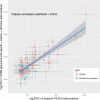Genome-wide meta-analysis identifies 127 open-angle glaucoma loci with consistent effect across ancestries
- PMID: 33627673
- PMCID: PMC7904932
- DOI: 10.1038/s41467-020-20851-4
Genome-wide meta-analysis identifies 127 open-angle glaucoma loci with consistent effect across ancestries
Abstract
Primary open-angle glaucoma (POAG), is a heritable common cause of blindness world-wide. To identify risk loci, we conduct a large multi-ethnic meta-analysis of genome-wide association studies on a total of 34,179 cases and 349,321 controls, identifying 44 previously unreported risk loci and confirming 83 loci that were previously known. The majority of loci have broadly consistent effects across European, Asian and African ancestries. Cross-ancestry data improve fine-mapping of causal variants for several loci. Integration of multiple lines of genetic evidence support the functional relevance of the identified POAG risk loci and highlight potential contributions of several genes to POAG pathogenesis, including SVEP1, RERE, VCAM1, ZNF638, CLIC5, SLC2A12, YAP1, MXRA5, and SMAD6. Several drug compounds targeting POAG risk genes may be potential glaucoma therapeutic candidates.
Conflict of interest statement
X.W. and A.A. are employed by and hold stock or stock options in 23andMe, Inc. J.W. is a consultant for Allergan, Editas, Maze, Regenxbio and has received sponsored research support from Aerpio Pharmaceuticals Inc. L.P. is a consultant for Eyenovia, Bausch + Lomb, Verily, and Nicox. T.L.Y. serves as a consultant to Aerpio Pharmaceuticals, Inc. A.P.K. is a consultant to Aerie, Allergan, Google Health, Novartis, Reichert, Santen and Thea. All remaining authors declare no competing interests.
Figures




References
Publication types
MeSH terms
Grants and funding
- MC_UU_00007/10/MRC_/Medical Research Council/United Kingdom
- MR/T040912/1/MRC_/Medical Research Council/United Kingdom
- MR/T019050/1/MRC_/Medical Research Council/United Kingdom
- R21 EY028671/EY/NEI NIH HHS/United States
- R01 EY018246/EY/NEI NIH HHS/United States
- MR/N003284/1/MRC_/Medical Research Council/United Kingdom
- R01 EY023242/EY/NEI NIH HHS/United States
- MC_UU_12015/1/MRC_/Medical Research Council/United Kingdom
- 14136/CRUK_/Cancer Research UK/United Kingdom
- G0401527/MRC_/Medical Research Council/United Kingdom
- R01 EY022305/EY/NEI NIH HHS/United States
- R01 EY015473/EY/NEI NIH HHS/United States
- R01 EY031424/EY/NEI NIH HHS/United States
- C864/A14136/CRUK_/Cancer Research UK/United Kingdom
- MC-UU_12015/1/MRC_/Medical Research Council/United Kingdom
- R01 EY027004/EY/NEI NIH HHS/United States
- G1000143/MRC_/Medical Research Council/United Kingdom
- P30 EY014104/EY/NEI NIH HHS/United States
- P30 EY031631/EY/NEI NIH HHS/United States
- MC_PC_13048/MRC_/Medical Research Council/United Kingdom
- R01 EY022891/EY/NEI NIH HHS/United States
LinkOut - more resources
Full Text Sources
Other Literature Sources
Miscellaneous

